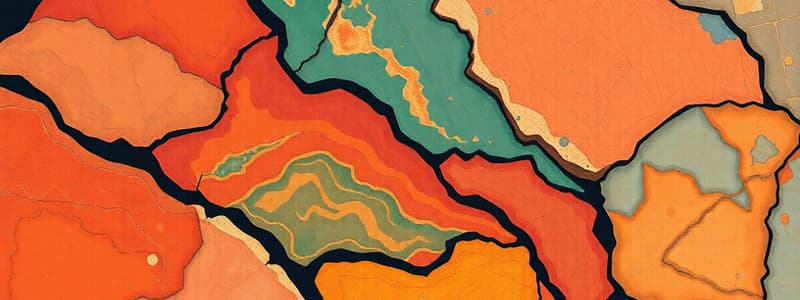Podcast
Questions and Answers
What is the primary origin of sediments that form sedimentary rocks?
What is the primary origin of sediments that form sedimentary rocks?
- Precipitation from the atmosphere
- Mechanical and chemical breakdown of other rocks (correct)
- Direct extraction from the Earth's mantle
- Crystallization from magma
How does the energy level of a transport medium relate to the size of the grains it can carry?
How does the energy level of a transport medium relate to the size of the grains it can carry?
- Higher energy levels transport smaller grains.
- Energy level is not related to grain size.
- Energy level only affects the shape of the grains.
- Higher energy levels transport larger grains. (correct)
What environmental conditions are most conducive to the formation of limestone?
What environmental conditions are most conducive to the formation of limestone?
- Warm, tropical, shallow, clear, oxygen-rich marine waters (correct)
- Cold, deep, turbulent marine waters
- Brackish, temperate, fast-moving waters
- Cold, high-pressure, anoxic waters
What is the significance of grain sorting in clastic sedimentary rocks?
What is the significance of grain sorting in clastic sedimentary rocks?
What conditions are required for the formation of evaporites?
What conditions are required for the formation of evaporites?
If a sedimentary rock contains a high proportion of feldspar, what can be inferred about its source?
If a sedimentary rock contains a high proportion of feldspar, what can be inferred about its source?
What is the primary difference between conglomerate and breccia?
What is the primary difference between conglomerate and breccia?
What factor primarily controls the color variations observed in mudstone?
What factor primarily controls the color variations observed in mudstone?
What process is vital to producing sedimentary rocks?
What process is vital to producing sedimentary rocks?
How does photosynthesis affect the precipitation of CaCO3 in marine environments?
How does photosynthesis affect the precipitation of CaCO3 in marine environments?
Which of the following mineral is more stable at the Earth's surface?
Which of the following mineral is more stable at the Earth's surface?
What is the relationship between lithostatic pressure and depth?
What is the relationship between lithostatic pressure and depth?
What is the critical difference between 'normal stress' and 'shear stress'?
What is the critical difference between 'normal stress' and 'shear stress'?
What is the primary role of fluids like H2O and CO2 in metamorphism?
What is the primary role of fluids like H2O and CO2 in metamorphism?
In contact metamorphism, what geological feature surrounds the magma intrusion?
In contact metamorphism, what geological feature surrounds the magma intrusion?
What is the main process that coal undergoes as it transitions from peat to anthracite?
What is the main process that coal undergoes as it transitions from peat to anthracite?
During metamorphism, which factor primarily dictates the final mineral composition of the rock?
During metamorphism, which factor primarily dictates the final mineral composition of the rock?
What distinguishes granoblastic metamorphic rocks?
What distinguishes granoblastic metamorphic rocks?
What is the primary textural feature of foliated metamorphic rocks?
What is the primary textural feature of foliated metamorphic rocks?
How do the conditions for Blueschist formation relate to typical metamorphic conditions?
How do the conditions for Blueschist formation relate to typical metamorphic conditions?
What is one key way to differentiate shale from phyllite?
What is one key way to differentiate shale from phyllite?
How does the metamorphic process change the density of a rock?
How does the metamorphic process change the density of a rock?
Which type of metamorphism is associated with high-temperature and low-pressure environment?
Which type of metamorphism is associated with high-temperature and low-pressure environment?
What is the correct ordering of metamorphic rocks from low to high grade metamorphism?
What is the correct ordering of metamorphic rocks from low to high grade metamorphism?
Which metamorphic rock is known for sometimes containing thin bands of slate or schist?
Which metamorphic rock is known for sometimes containing thin bands of slate or schist?
During metamorphism, ions are able to move through...
During metamorphism, ions are able to move through...
Compositional banding in gneiss is due to...
Compositional banding in gneiss is due to...
Migmatites indicates that precursor rock will...
Migmatites indicates that precursor rock will...
What kind of depositional location allows for coal to form?
What kind of depositional location allows for coal to form?
How does differential stress lead to foliation?
How does differential stress lead to foliation?
What is meant by 'exhumation'?
What is meant by 'exhumation'?
What is the role of agitation in limestone production?
What is the role of agitation in limestone production?
Why is Bowen's Reaction Series relevant to discussions of clastic rocks?
Why is Bowen's Reaction Series relevant to discussions of clastic rocks?
If a rock experiences some heat and pressure, it is...
If a rock experiences some heat and pressure, it is...
The size of mineral crystals grows as temperatures...
The size of mineral crystals grows as temperatures...
If a sedimentary rock is red, it indicates...
If a sedimentary rock is red, it indicates...
Which ocean ridge system has the most widespread metamorphism?
Which ocean ridge system has the most widespread metamorphism?
What are important parameters for considering the formation of metamorphic rocks?
What are important parameters for considering the formation of metamorphic rocks?
Slate is associated with which metamorphic environment?
Slate is associated with which metamorphic environment?
What are some economic considerations of discussing sedimentary rocks?
What are some economic considerations of discussing sedimentary rocks?
What is the technical name for when something undergoes a chemical change by interacting with water?
What is the technical name for when something undergoes a chemical change by interacting with water?
Flashcards
Sediments
Sediments
Rock fragments that settle and accumulate in layers after being transported or precipitated.
Sedimentary Rock Types
Sedimentary Rock Types
Rock types based on the source of the material.
Detrital/clastic rocks
Detrital/clastic rocks
Transported sediment as solid particles
Chemical rocks
Chemical rocks
Signup and view all the flashcards
Weathering
Weathering
Signup and view all the flashcards
Sediments
Sediments
Signup and view all the flashcards
Clastic Sedimentary Rocks
Clastic Sedimentary Rocks
Signup and view all the flashcards
Biochemical Sedimentary Rocks
Biochemical Sedimentary Rocks
Signup and view all the flashcards
Organic Sedimentary Rocks
Organic Sedimentary Rocks
Signup and view all the flashcards
Chemical Sedimentary Rocks
Chemical Sedimentary Rocks
Signup and view all the flashcards
Conglomerate
Conglomerate
Signup and view all the flashcards
Breccia
Breccia
Signup and view all the flashcards
Arkose
Arkose
Signup and view all the flashcards
Graywacke
Graywacke
Signup and view all the flashcards
Shale
Shale
Signup and view all the flashcards
Mudstone
Mudstone
Signup and view all the flashcards
Limestone
Limestone
Signup and view all the flashcards
Dolostone
Dolostone
Signup and view all the flashcards
Chert
Chert
Signup and view all the flashcards
Rock salt
Rock salt
Signup and view all the flashcards
Rock Gypsum
Rock Gypsum
Signup and view all the flashcards
Coal
Coal
Signup and view all the flashcards
Chief Constituents of Clastic Rocks
Chief Constituents of Clastic Rocks
Signup and view all the flashcards
Grain Sorting
Grain Sorting
Signup and view all the flashcards
Mudstone
Mudstone
Signup and view all the flashcards
Sandstone
Sandstone
Signup and view all the flashcards
Chemical Sedimentary Rocks
Chemical Sedimentary Rocks
Signup and view all the flashcards
Limestone
Limestone
Signup and view all the flashcards
Chert
Chert
Signup and view all the flashcards
Evaporites
Evaporites
Signup and view all the flashcards
Coal
Coal
Signup and view all the flashcards
Economic Considerations
Economic Considerations
Signup and view all the flashcards
Metamorphism
Metamorphism
Signup and view all the flashcards
Temperature in Metamorphism
Temperature in Metamorphism
Signup and view all the flashcards
Lithostatic Confining
Lithostatic Confining
Signup and view all the flashcards
Directed (differential)
Directed (differential)
Signup and view all the flashcards
Hydrothermal Metamorphism
Hydrothermal Metamorphism
Signup and view all the flashcards
Dynamothermal (orogenic)
Dynamothermal (orogenic)
Signup and view all the flashcards
Contact Metamorphism
Contact Metamorphism
Signup and view all the flashcards
Granoblastic Rocks
Granoblastic Rocks
Signup and view all the flashcards
Foliated Rocks
Foliated Rocks
Signup and view all the flashcards
Study Notes
- Lecture 4/5: Earth Materials II & III review earth materials, with a focus on sedimentary and metamorphic rocks.
Sedimentary Rocks
- Sedimentary rocks are formed from rock fragments that settle and accumulate in layers after being transported or precipitated.
- The term "sediment" comes from the Latin word "sedimentum," which means "to settle."
- Sedimentary rocks originate from mechanical or chemical breakdown.
- They make up only 5% of Earth's outer 15 km by volume, but cover 75% of exposed rocks.
- These contain evidence of past environments, including tectonics, climate, and life (fossils).
- Rock types are based on the source of the material
- Detrital or clastic rocks are transported sediment as solid particles.
- Chemical rocks are sediment that precipitates from a solution or extracted from water by organisms (converted to shells/skeletons).
Sedimentary processes
- Physical features in the rock reveal how sediments were deposited and the environmental conditions of deposition.
- Begins, with weathering that breaks down rock.
- Follows, erosion that leads to mass wasting.
- Next, transport leading to relocation.
- Afterward, deposition of sediments.
- Ends, with lithification via compaction & cementation to create rock.
Weathering
- Weathering involves physical and chemical changes that weaken and break down rocks when exposed to the atmosphere and biosphere.
- Factors controlling weathering include the parent rock (e.g., granite vs. salt), climate (temperature and rain), soil and vegetation cover, and time.
Types of Sedimentary Rocks
- Physical and chemical weathering provide the particles and dissolved ions needed for all sedimentary rocks
- Geologists classify them into four classes:
- Clastic: Loose rock fragments (clasts) held together by cement.
- Biochemical: Cemented shells of organisms.
- Organic: Carbon-rich remains of once-living organisms.
- Chemical: Minerals that crystallize directly from the water.
Clastic Sedimentary Rocks
- These rocks are made of quartz, feldspars, micas, and clay minerals, which are stable on Earth's surface.
- Texture reflects process of deposition.
- Grain size is related to the parent rock properties and is proportional to the energy level of the transport medium (hi-E = smaller grains).
- Sorting is determined by distribution of sizes, shapes, and densities from a transport medium that selects particles of different sizes, shapes, and sorting..
- Grain Shape: ranging from angular to rounded shapes that are proportional to energy level or distance traveled (more collisions = rounded)
Mudstone
- Consists of clay to silt-sized particles in thin layers.
- Commonly forms in calm waters (lakes, lagoons, and deep ocean).
- Sedimentary rocks are more than 50% mudstone
- Mudstone color varies: red (Fe & O rich), green (Fe & O poor), black (not enough O to decompose organic matter).
Sandstone
- Mostly composed of sand-sized particles; primarily quartz
- Found in rivers, beaches, glaciers, mountains, and deserts.
Conglomerate and Breccia
- Particles are over 2 mm in diameter within a finer-grained matrix.
- Conglomerate contains rounded gravels.
- Breccia contains angular particles.
Chemical Sedimentary Rocks
- Chemical sedimentary rocks consists of precipitated material that was once in solution.
- Precipitation occurs through:
- Inorganic processes where minerals in water precipitate or
- Organic processes (biogenic origin).
Limestone
- Limestone is a common chemical sedimentary rock.
- It forms is 10-15% of sedimentary rocks.
- It is composed chiefly of calcite (CaCO3).
- This rock forms in warm, tropical, shallow, clear, and O2-rich marine water.
- Marine biochemical limestones form from coral reefs.
- They are made of sediments derived from the shells of once-living organisms.
- Hard mineral skeletons accumulate after the death of the organisms
- Inorganic limestones include travertine, speleothems and tufa.
- Travertine is calcium carbonate (CaCO3) that is precipitated from groundwater.
- Dissolved calcium (Ca2+) reacts with bicarbonate (HCO3-).
- When CO2 is expelled into the air, it causes CaCO3 to precipitate, and this process occurs in thermal (hot) springs and caves.
- CaCO3 precipitation is controlled by the solubility of CaCO3, which is proportional to CO2 in water and a water's level of agitation.
Chert
- Chert is a chemical sedimentary rock that contains microcrystalline quartz.
- It may contain silica, skeletons of small marine plankton, or varieties.
Evaporites
- Trigger deposition of inorganic chemical precipitates.
- Form is restricted basins with warm temperatures
- Rock salt and rock gypsum are some examples of this sedimentary rock.
Coal
- Coal is a chemical sedimentary rock that is made from the decay and compression of land plants rich in resins, waxes, and lignins.
- Organic matter accumulates in anoxic environment swamps.
- Peat converts into lignite, bituminous, and anthracite coal after burial.
- Largely distributed and readily available supply.
Economic and Scientific Considerations
- Economic:
- Coal
- petroleum & natural gas
- iron, aluminum, & manganese
- phosphates
- Science:
- Fossils
- Geologic Histories
Important factors regarding Sedimentary Rocks
- Sedimentary rocks can be formed in glacial, desert, fluvial, and lake environments.
Metamorphism
- The term "metamorphism" comes from the Greek words meta (to change) and morphe (form).
- Metamorphism occurs when temperature (T), pressure (P), and chemical reactions alter mineral content and structure of pre-existing rock.
- This process only occurs in solid-state, without melting.
- Metamorphism happens when T & P break some atomic bonds.
Metamorphic rocks
- Produced from:
- Igneous
- Sedimentary
- Other metamorphic rocks
- To understand all metamorphic rocks, it's important to consider three questions:
- What is the rock now?
- What was it before?
- What caused the change tectonically?
Controls of metamorphism
- Temperature
- Is not absolute, but a change in temperature.
- Rocks shift to equilibrium with new environmental conditions.
- This produces recrystallization and stable minerals.
- Geothermal gradient ranges from 10°C/km in stable continents to over 100°C/km in tectonically active areas.
- Pressure (stress)
- lithostatic/confining:
- pushes on all directions equally.
- rock gets more dense without change in shape.
- This process increases at 0.3 kbar/km depth.
- directed (differential):
- Pressure is at its greatest in one direction.
- Results to change in shape.
- New growth minerals are aligned perpendicular to pressure to create foliation.
- Pressure is at its greatest in one direction.
- lithostatic/confining:
Differential Stress
- Normal stress operates perpendicular to surface, and includes push-together compression and pull-apart tension.
- Shear stress acts parallel to a surface, smearing it.
- Fluid activity
- Includes H2O and CO2, which enhances migration and potential for reaction.
- Hydrothermal alteration is called metasomatism.
- The degree of metamorphism is controlled by the protolith
Example of Metamorphism
- At 200°C, sandy limestone consists of quartz and calcite.
- At 600°C, minerals are no longer stable together; each exists alone but together forms an aluminosilicate which are from the chemical formula: SiO2 + CaCO3 = CaSiO3 + CO2 is wollastonite.
- Elements do not change only restructure and regrow.
- During this process, CO2 is released.
- If CO2 leaves and rock cools reverts to quartz + calcite cannot occur unless CO2 is added.
Metamorphic Environments
- Metamorphic environments are most common at the plate boundaries
Regional Metamorphism
- Burial environments involved in the T & lithostatic P in sedimentary basins.
- Mississippi Delta, Bay of Bengal are the locations.
- Pressure increases as growing pile of overlying sediments increases T with increasing depth
- During Dynamothermal (Orogenic) conditions there is response to changes in pressure and temperature with large-scale tectonics and directed pressure that causes foliation in Himalayas, Appalacian regions.
Metamorphic Grade
- The metamorphic grade from low to high occurs between slate, phyllite, schist, gneiss.
Contact Metamorphism
- It is the response to change in temperature in cooler rocks, and is a local scale.
- An aureole has a zone of alteration that forms in the surrounding magma to the original rock.
- Hydrothermal Metamorphism*
- Includes chemical reactions caused by hot, ion-rich fluids in rock fissures and cracks and is common along mid-ocean ridges.
Classification
- The degree of metamorphism is reflected in texture and this is also reflected in mineralogy.
Granoblastic Rocks
- Includes non-foliated rocks that have crystal shapes that grow uniformly and are interlocking.
- Monomineralic rocks are granoblastic.
Hornfels
- Is developed through high-T contact metamorphism in uniform that undergoes minimal deformation.
Quartzite
- Is very hard and a nonfoliated white rock found in sandstone.
Marble
- Marble is a metamorphic products of T & P on limestone.
Foliated Rocks
- It is named after its "leaf-like" appearance.
- A common textural feature is the nature of foliation (flat or wavy parallel planes)
Slate
- It is a foliated rock made in low temperature and pressure environments.
Phyllite
- Forms at a higher level of temperature and pressure than slate.
Schist
- This is more intensely metamorphosed, the rock has flaky and larger crystals, easily seen by the naked eye.
Gneiss
- This textured rock forms under a high pressure and temperature environment.
Migmatite
- Forms when at a high temperature where beginning to melt a rock's precursor.
Exhumation
- Metamorphic rocks that return to earth's surface through a process called exhumation.
- This process is a result of mountains decaying through eduction, extensional thinning, and erosion.
Studying That Suits You
Use AI to generate personalized quizzes and flashcards to suit your learning preferences.




